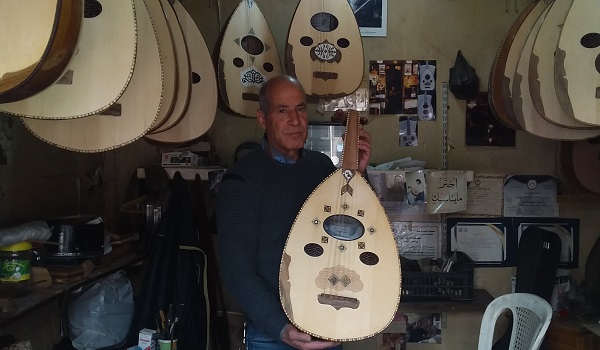In 1979, Anton Tawil made the first oud, pear-shaped traditional musical instrument with the imprint of the Damascene craftsman.
The 64-year-old craftsman learned the stages of making the oud from his father inside a small workshop in their house in Al-Mashariqa neighborhood in the Old city of Damascus. He gained the secret of making this instrument and preserved it, so he deserved to be the master of this craft.
Ibrahim, Anton’s father, has been making oud since the late of 1950s, so that Anton inherited this industry from his father, and also passed on it to his daughter, Mary.
“There were around 20 workshops before the start of the crisis in the country in 2011. These workshops were in Damascus, Aleppo and Hama… Now there are no more than six, a few of them are in Damascus….In a single month, I used to sell scores of ouds, many of them for abroad, including Europe and Canada, while nowadays, months go by without selling anything,” Tawil told Syria Times e-newspaper. .
He made it clear that the Damascene oud can last around 65 years without needing maintenance because of the used Damascene wood and the way it is dried and cured.
“ We use walnut wood, which has a very high quality and it is available in the Eastern Ghouta of Damascus. Polishing the oud by hand takes around 6 hours. While with machine, it’s done in 15 minutes, “ the craftsman added.
 The first Damascene oud was produced in 1897 by Abdo al Nahhat, who became one of the country’s most renowned oud-makers.
The first Damascene oud was produced in 1897 by Abdo al Nahhat, who became one of the country’s most renowned oud-makers.
In the early 20th century, the oud became the favoured instrument among Syrians, played at marriages or during gatherings of women.
By the end of 2022, The United Nations Educational, Scientific and Cultural Organization (UNESCO) included the Syrian Oud on its list of intangible cultural heritage, due to its unique sound and hand-crafted curves made with great precision.
Although the oud is found throughout the region, the Syrian oud is known for its pure tones and unique, harmonious sounds.
On this point, Tawil said: “There are many composers who rely on the oud in their melodies. They do not use any other instrument except the Syrian oud, because it allows playing more than two hundred maqams, as it presents the whole, half and quarter tones.”
By: Basma Qaddour


 Home
Home